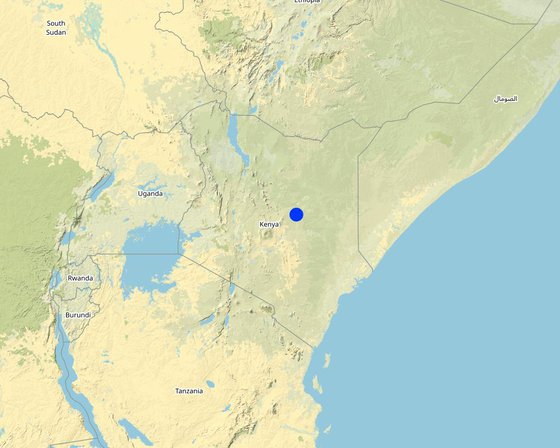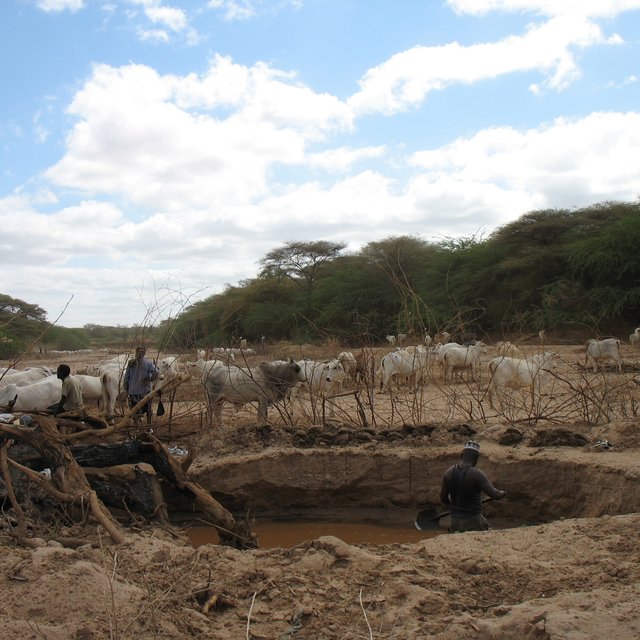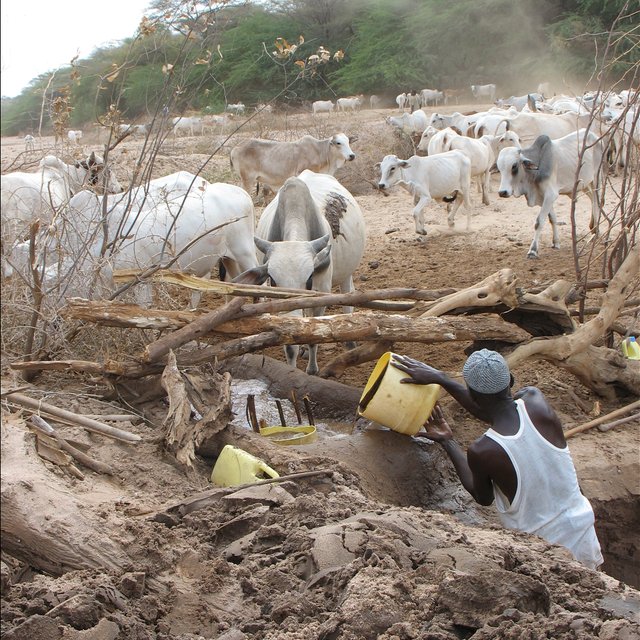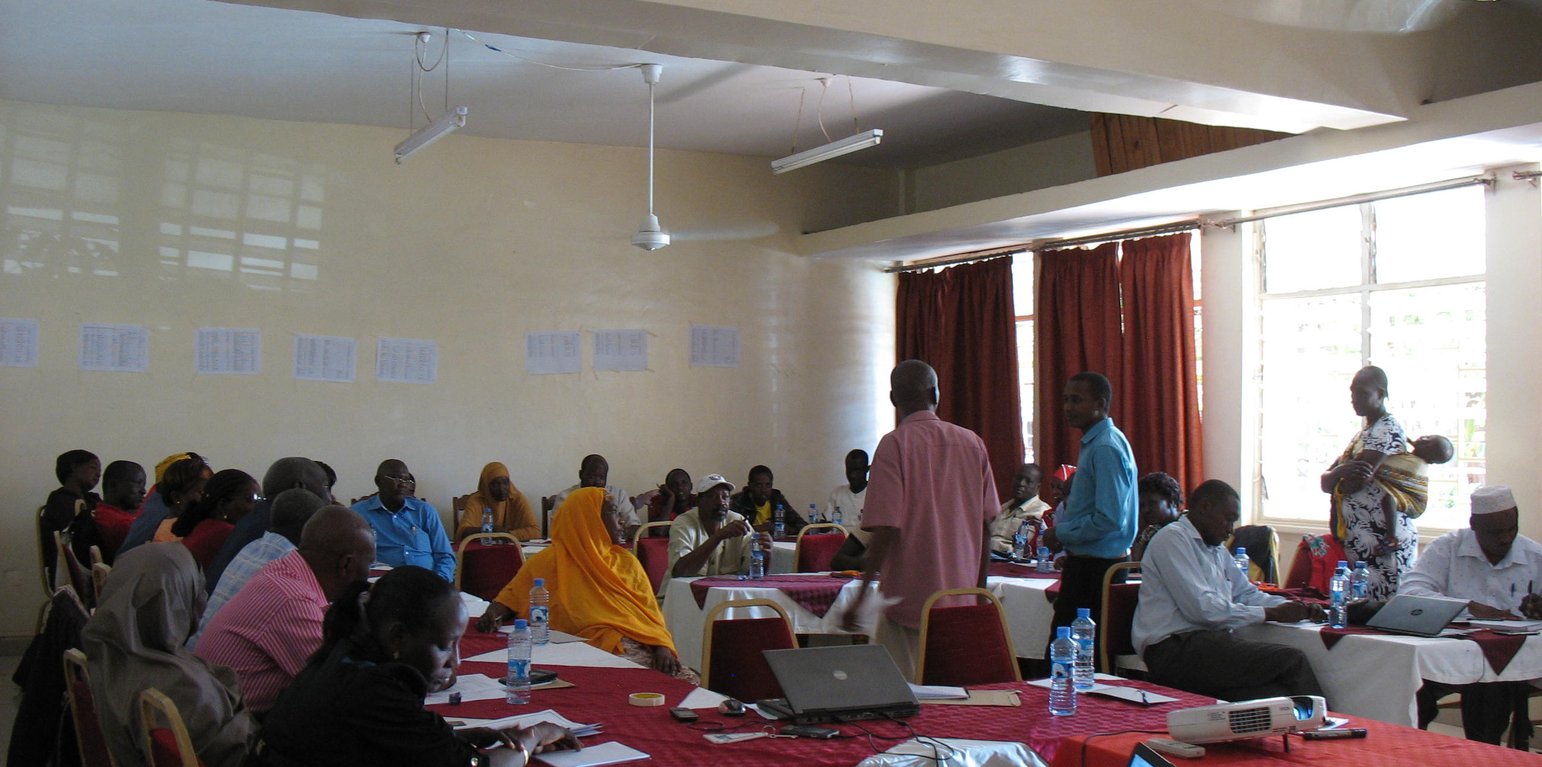Inclusive strategic planning for water, energy and climate change in the rangelands
(كينيا)
Devolved strategic planning
الوصف
Inclusive strategic planning for water, energy and climate change in the rangelands at county, sub-county, ward and location levels. This involves convening stakeholder groups and reviewing databases to prepare for future needs for rangeland, water and other resources under changing climatic conditions.
This participatory approach consists of strategic planning through a method that embraces the perspectives of the stakeholder groups, including rangeland resource user associations. Strategic planning is needed in order to rebalance the threats and opportunities created by the annual cycle of droughts and floods, and to coordinate the efforts of local, national and international actors. Key elements of the strategic planning approach include:
i) Scientific tools, databases, systems, and capacities to observe and monitor climate effects, extractions and of water within the catchment;
ii) Clean, affordable and friendly technological solutions to redistribute and conserve water and energy supplies where they are needed within the catchment, particularly during drought and floods;
iii) Inclusive institutions, including active local participation both formally established and customary, to prioritize, guide, supervise and maintain the necessary information systems and infrastructure.
The County Ministry of Water, Energy and Climate Change encourages, and is involved in, a strong community consultation process. It publicly reviews its databases to prioritize investments for a multi-sectoral Strategic Plan. The plan is used to guide investments from the county budget, and also by other actors intending to contribute to managing water, energy and climate change within the county. In the past, the lack of such a strategy and consultation process has held back coordination amongst resource users, and limited the effectiveness of many county and donor-supported interventions, especially in the rangeland areas.
2016-7 was the first time that such an approach to planning had been explored by the county officials. Over 100 women and men representing local customary resource user associations, women’s groups, formal water resource user associations, water committees, irrigation committees, ward adaptation planning committees and others took part in a series of sub-county level consultation meetings. These were conducted in appropriate languages, depending on the mix of participants. The public meetings were preceded by technical preparatory meetings amongst the county technical officers and resource persons.
The Sector Strategic Plan feeds into the preparation of the County Integrated Development Plan (with a 5-year timeframe), as well as the annual budgeting for the county government and its development partners. The recommendations also support and feed into ongoing catchment level planning, as well as broader national planning debates in Kenya, particularly those concerning the Arid and Semi-Arid Lands (ASALs). The overall objective of the Strategic Plan is to enable Isiolo county and its neighbouring ASAL counties in Kenya - and the Horn of Africa - to achieve their full potential as the crucibles of national and global prosperity, security and spiritual well-being.
الموقع

الموقع: Both urban and rural areas of Isiolo county., Isiolo, كينيا
المرجع الجغرافي للمواقع المختارة
تاريخ البدء: غير متاح
سنة الإنهاء: غير متاح
نوع النهج
-
تقليدي/أصلي
-
مبادرة محلية حديثة/مبتكرة
-
قائم على مشروع/برنامج

Watering livestock in the Waso Riverbed in Merti (Caroline King Okumu)

Watering livestock in the Waso Riverbed,Merti (Caroline King Okumu)
غايات النهج والبيئة المواتية
الغايات/الأهداف الرئيسية للنهج
The overall objective of the Strategic Plan is to enable Isiolo county and its neighbouring ASAL counties in Kenya – as well as in the Horn of Africa - to achieve their full potential as the crucibles of national and global prosperity, security, and spiritual well-being.
الشروط التي تمكن من تنفيذ التقنية/التقنيات المطبقة في إطار النهج
-
المعايير والقيم الاجتماعية /الثقافية/ الدينية: The approach is embedded in the local institutional processes and therefore easy to implement.
-
توفر/الوصول إلى الموارد والخدمات المالية: County governments have some resources to convene meetings, but communities make their own contributions to prepare and support implementation of the approach.
-
الإطار المؤسساتي: Ward-level adaptation planning committees connect the county level process to the local resource user institutions at the location level.
-
التعاون/التنسيق بين الجهات الفاعلة: Many NGOs and local organizations support the implementation of the approach and will benefit from improved coordination and planning.
-
الإطار القانوني (حيازة الأراضي، وحقوق استخدام الأراضي والمياه): 2010 national constitutional reforms promote devolution. Traditional customary institutions are actively and locally respected.
-
السياسات: 2010 Constitution, 2030 Plan for the ASALs.
-
حوكمة الأراضي (صنع القرار والتنفيذ والإنفاذ): County government makes informed decisions following consultation with communities and the formation of databases.
-
المعرفة حول الإدارة المستدامة للأراضي، والوصول إلى الدعم الفني: Traditional skills are much used as an input to participatory resource maps and databases.
-
الأسواق (لشراء المدخلات وبيع المنتجات) والأسعار: Ensures security and therefore the market thrives.
-
عبء العمل، توفر القوى العاملة: Youth provide manpower on a voluntary basis.
الظروف التي تعيق تنفيذ التقنية/التقنيات المطبقة في إطار النهج
-
المعايير والقيم الاجتماعية /الثقافية/ الدينية: The occurrence of crises and emergencies (such as drought) routinely disrupts long-term strategic planning.
-
توفر/الوصول إلى الموارد والخدمات المالية: Very few donors are willing to provide funds to support this approach.
-
الإطار المؤسساتي: Collision between the mandates of traditional and formal structures.
-
التعاون/التنسيق بين الجهات الفاعلة: Government and some NGOs occasionally establish parallel policy processes.
-
الإطار القانوني (حيازة الأراضي، وحقوق استخدام الأراضي والمياه): Weak catchment institutions and coordination.
-
السياسات: Traditional rules not known to everyone.
-
حوكمة الأراضي (صنع القرار والتنفيذ والإنفاذ): Literacy and language barriers (though can be overcome through good communication, mobility and outreach by county officers)
-
المعرفة حول الإدارة المستدامة للأراضي، والوصول إلى الدعم الفني: Little technical support.
-
الأسواق (لشراء المدخلات وبيع المنتجات) والأسعار: The approach is social rather than market oriented.
-
عبء العمل، توفر القوى العاملة: Volunteers sometimes don’t come out for work.
مشاركة وأدوار الأطراف المعنية
الأطراف المعنية بالنهج وأدوارها
| ما هي الجهات المعنية / الكيانات المنفذة التي شاركت في النهج؟ |
حدد الأطراف المعنيين |
وصف أدوار الأطراف المعنية |
| مستخدمو الأراضي المحليون/المجتمعات المحلية |
Community members, Elders’ Council (Dedha in Boran setups). |
Agree on the pasture and water management approach and implement it. |
| المنظمات المجتمعية |
Ward Adaptation Planning Committees. |
Implement community plans and fundraise for them. |
| منظمة غير حكومية |
RAP, MIDP and Adaptation Consortium (ADA). |
Support communities in implementing the approach. |
| الحكومة المحلية |
Isiolo County Government’s Department of Water, Energy and Climate Change. |
Participate in the implementation of the approach. |
الوكالة الرائدة
Isiolo County Government
انخراط مستخدمي الأراضي المحليين/المجتمعات المحلية في المراحل المختلفة للنهج
غير موجود
سلبي
الدعم الخارجي
تفاعلي
التعبئة الذاتية
المبادرة/التحفيز
County government, National Drought Management Authority, Water Resource Management Authority, RAP, IIED.
التخطيط
Local customary resource user associations, women’s groups, formal water resource user associations, water committees, irrigation committees, ward adaptation planning committees and others.
التنفيذ
County government and resource users.
الرصد/التقييم
County government and resource users.
None
National government, international donors.
مخطط التدفق
Local village level community institutions are involved in the planning and management of resources. The community institutions at village level are connected to those at ward level, which connect to sub-county and county level institutions for planning. Lower level institutions had not ever previously been asked for their opinions and inputs.
![]()
المؤلف: Ibrahim Jarso
اتخاذ القرار بشأن اختيار تقنية الإدارة المستدامة للأراضي
وقد تم اتخاذ القرارات من قبل
-
مستخدمو الأراضي وحدهم (المبادرة الذاتية)
-
مستخدمو الأراضي بشكل أساسي، بدعم من متخصصي الإدارة المستدامة للأراضي
-
جميع الجهات الفاعلة ذات الصلة، كجزء من نهج تشاركي
-
متخصصون في الإدارة المستدامة للأراضي بشكل أساسي، بعد التشاور مع مستخدمي الأراضي
-
متخصصون في الإدارة المستدامة للأراضي بمفردهم
-
السياسيون / القادة
تم اتخاذ القرارات بناء على
-
تقييم المعرفة الموثقة جيدًا بشأن الإدارة المستدامة للأراضي(اتخاذ القرارات القائمة على الأدلة)
-
نتائج البحوث
-
خبرة وآراء شخصية(غير موثقة)
الدعم الفني وبناء القدرات وإدارة المعرفة
شكلت الأنشطة أو الخدمات التالية جزءًا من النهج
-
بناء القدرات/التدريب
-
خدمة استشارية
-
تعزيز المؤسسات (التطوير التنظيمي)
-
الرصد والتقييم
-
البحوث
تعزيز المؤسسات
تم تعزيز/إنشاء المؤسسات
-
لا
-
نعم، قليلا
-
نعم، باعتدال
-
نعم، إلى حد كبير
صف المؤسسة والأدوار والمسؤوليات والأعضاء وما إلى ذلك.
County government's officers skills in participatory engagement were improved.
نوع الدعم
-
مالي
-
بناء القدرات/التدريب
-
معدات
مزيد من التفاصيل
Support was provided on the job.
التمويل والدعم المادي الخارجي
الميزانية السنوية بالدولار الأمريكي لمكون الإدارة المستدامة للأراضي
-
< 2000
-
10,0000-2,000
-
100,000-10,000
-
1,000000-100،000
-
> 1,000,000
Precise annual budget: غير متاح
Funds were provided from DfID and other sources were also used to support this process.
The financial support to conduct community consultation meetings was provided by Cordaid.
تم تقديم الخدمات أو الحوافز التالية لمستخدمي الأراضي
-
الدعم المالي/المادي المقدم لمستخدمي الأراضي
-
إعانات لمدخلات محددة
-
الائتمان
-
حوافز أو وسائل أخرى
تحليل الأثر والتصريحات الختامية
آثار النهج
لا
نعم، قليلا
نعم، باعتدال
نعم، إلى حد كبير
هل ساهم النهج في تمكين مستخدمي الأراضي المحليين وتحسين مشاركة الأطراف المعنية؟
The communities were able to participate in planning to improve development at local grassroots level.
هل مكّن النهج من اتخاذ القرارات المبنية على الأدلة؟
The Approach was able to offer opportunities for all community groups to provide their inputs into the process of strategic planning at county level, allowing room for evidence-based decisions informed by people’s experience.
هل ساعد النهج مستخدمي الأراضي على تنفيذ وصيانة تقنيات الإدارة المستدامة للأراضي؟
The Approach allowed community members to document their needs and priorities in line with their sustainable land management systems, which were traditional and holistic.
هل نجح النهج في تحسين التنسيق والتنفيذ الفعال من حيث التكلفة لأنشطة الإدارة المستدامة للأراضي؟
The Approach brought together key community-level stakeholders and coordinated them in planning.
هل نجح النهج في تعبئة/تحسين الوصول إلى الموارد المالية لتنفيذ الإدارة المستدامة للأراضي؟
The Approach produced a participatory and inclusive plan that included costs for support at different levels and this helped in fundraising for community investments.
هل أدى النهج إلى تحسين معرفة وقدرات مستخدمي الأراضي على تنفيذ الإدارة المستدامة للأراضي؟
County government officers learnt that the approach was very productive in bringing out ideas from the grassroots to inform strategic planning.
هل أدى النهج إلى تحسين معرفة وقدرات الأطراف المعنية الأخرى؟
The stakeholders that came together learnt a lot from the process and multi-stakeholder forums like WASH clubs were formed out of the discussions.
هل ساهم النهج في بناء/تعزيز المؤسسات والتعاون بين الأطراف المعنية؟
Many institutions that were consulted in the implementation of the approach were strengthened in their capacity - and were able to engage in subsequent government-community consultations that came up later.
هل ساهم النهج في تمكين الفئات المحرومة اجتماعيا واقتصاديا؟
The approach ensured consultations with special interest/disadvantaged groups.
هل أدى النهج إلى تحسين المساواة بين الجنسين وتمكين النساء والفتيات؟
A significant proportion of women and girls attended the meetings and made critical and unique contributions. Deliberate efforts were undertaken to ensure inclusivity by holding women’s meetings to seek their inputs.
هل شجع النهج الشباب/الجيل القادم من مستخدمي الأراضي على الانخراط في الإدارة المستدامة للأراضي؟
Young people were also represented in the consultations.
هل أدى النهج إلى تحسين الوصول إلى المياه والصرف الصحي؟
The approach identified challenges, opportunities and actions that could be undertaken in improving access to water and sanitation in the development of a strategic plan.
هل أدى النهج إلى استخدام طاقة/ مصادر طاقة أكثر استدامة؟
The approach identified locally utilisable sources of energy, and encouraged the use of clean and green energy.
هل أدى النهج إلى تحسين قدرة مستخدمي الأراضي على التكيف مع التغيرات المناخية/الظواهر المناخية المتطرفة والتخفيف من الكوارث المرتبطة بالمناخ؟
The approach allowed the county government officers to engage with the community in discussions on climate-related disasters as well as their elaborated traditional systems of grazing. Communities were advised to also use scientific measures, like utilization of CIS forecasts, to deal with climate-related disasters.
المحفز الرئيسي لقيام مستخدمي الأراضي بتنفيذ الإدارة المستدامة للأراضي
-
زيادة الإنتاج
-
زيادة الربح (القدرة)، وتحسين نسبة التكلفة إلى العائد
-
الحد من تدهور الأراضي
-
الحد من مخاطر الكوارث
-
انخفاض عبء العمل
-
المدفوعات/ الإعانات
-
القواعد واللوائح (الغرامات) / الإنفاذ
-
الوجاهة والضغط الاجتماعي/التماسك الاجتماعي
-
الانتماء إلى حركة/ مشروع/ مجموعة/ شبكات
-
الوعي البيئي
-
العادات والمعتقدات والأخلاق
-
تعزيز المعرفة والمهارات في مجال الإدارة المستدامة للأراضي
-
تحسينات جماليية
-
التخفيف من حدة الصراع
استدامة أنشطة النهج
هل يمكن لمستخدمي الأراضي الحفاظ على استدامة ما تم تنفيذه من خلال النهج (بدون دعم خارجي)؟
Community members can demand participatory and inclusive development in all government plans and policies, in the way the strategic plan for water sector was developed by the Isiolo County Government's department of Water, Energy and Climate Change.
الاستنتاجات والدروس المستفادة
نقاط القوة: وجهة نظر مستخدم الأرض
-
All community groups are given an opportunity to contribute to the planning process.
-
Hidden community concerns and challenges are brought out by the participatory process.
-
County government officers were able to hear first-hand community issues and respond to community questions regarding their responsibilities.
نقاط القوة: وجهة نظر جامع المعلومات أو غيره من الأشخاص الرئيسيين لمصدر المعلومات
-
The inclusive and participatory process was extremely productive in bringing out issues.
-
Community knowledge of their challenges and optimistic ideas for possible solutions were very enriching.
-
Women’s participation and their contribution to issues was unexpectedly high and demonstrates progress towards gender equity.
نقاط الضعف / المساوىء / المخاطر: وجهة نظر مستخدم الأرضكيفية التغلب عليها
-
The Approach was unable to reach all villages in the county to seek their inputs.
Representatives from all villages can be convened at ward level and advised to make cross-consultations before attending planning meetings.
-
Low literacy levels meant that not all people could engage properly with the formal planning process.
Using translators of local vernacular helped to reduce this challenge.
نقاط الضعف / المساوىء / المخاطر: وجهة نظر جامع المعلومات أو غيره من الأشخاص الرئيسيين لمصدر المعلوماتكيفية التغلب عليها
-
The process was relatively expensive compared to previous county engagements.
Explain the value of county-community engagements in planning to communities, and encourage other stakeholders to support the process also.
-
The process took a long time to complete.
The team conducting the public engagement can conduct more than one initiative simultaneously and thereby economise on time.
المراجع
المُراجع
-
Hanspeter Liniger
-
Rima Mekdaschi Studer
-
Donia Mühlematter
-
Joana Eichenberger
تاريخ التوثيق: 13 مارس، 2018
اخر تحديث: 2 نوفمبر، 2021
الأشخاص الرئيسيين لمصدر المعلومات
-
IBRAHIM JARSO (jarsoibra@gmail.com) - متخصص في الإدارة المستدامة للأراضي
-
Caroline King-Okumu (caroking@yahoo.com) - متخصص في الإدارة المستدامة للأراضي
الوصف الكامل في قاعدة بيانات WOCAT
بيانات الإدارة المستدامة للأراضي المرتبطة
تم تسهيل التوثيق من قِبَل
المؤسسة
- Resource Advocacy Programme (RAP) - كينيا
المشروع
- Book project: Guidelines to Rangeland Management in Sub-Saharan Africa (Rangeland Management)
- Strengthening Adaptation and Resilience to Climate Change in Kenya Plus (StARCK+)
المراجع الرئيسية
-
Recommendations to the County Government of Isiolo for Preparation of a Strategic Plan on Water, Energy and Climate Change: IIED Website
روابط للمعلومات ذات الصلة المتوفرة على الإنترنت






